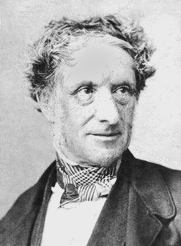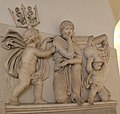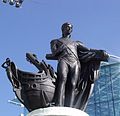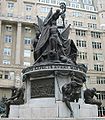Richard Westmacott
Sir Richard Westmacott | |
|---|---|
 | |
| Born | 15 July 1775 London, England |
| Died | 1 September 1856 (aged 81) London, England |
| Resting place | Chastleton, Oxfordshire |
| Nationality | British |
| Known for | sculpture |
Sir Richard Westmacott RA (15 July 1775 – 1 September 1856) was a British sculptor.[1]
Life and career
[edit]Westmacott studied with his father, also named Richard Westmacott, at his studio in Mount Street, off Grosvenor Square in London before going to Rome in 1793 to study under Antonio Canova.[2] Westmacott devoted all his energies to the study of classical sculpture, and throughout his life his real sympathies were with pagan rather than with Christian art. Within a year of his arrival in Rome he won the first prize for sculpture offered by the Florentine Academy of Arts, and in the following year he gained the papal gold medal awarded by the Academy of St Luke with his bas-relief of Joseph and his brothers.[3] On returning to England in 1797, he set up a studio, where John Edward Carew and Musgrave Watson gained experience.
Westmacott had his own foundry at Pimlico, in London, where he cast both his own works, and those of other sculptors, including John Flaxman's statue of Sir John Moore for Glasgow. Late in life he was asked by the Office of Works for advice on the casting of the relief panels for Nelson's Column.[4] He also had an arrangement with the Trustees of the British Museum, which allowed him to make moulds and supply plaster casts of classical sculpture in the museum's collection to country house owners, academies and other institutions.[4]

Westmacott exhibited at the Royal Academy between 1797 and 1839. His name is given in the catalogues as "R. Westmacott, Junr." until 1807, when the "Junr." was dropped.[5] He was elected an associate of the Royal Academy in 1805, and a full academician in 1811.[2] His academy diploma piece, a marble relief of Jupiter and Ganymede, remains in the academy's collection.[6] He was professor of sculpture at the academy from 1827 until his death.[2] He received his knighthood on 19 July 1837.[7][8] In 1852 when contacted by the Corporation of London about a possible sculpture commission, Westmacott replied that he had not been active as a sculptor for some years.[9]
Works
[edit]Among Westmacott's works are the reliefs for the north side of Marble Arch, the pedimental sculptures of figures representing The Progress of Civilisation on the British Museum,[10] the Achilles of the Wellington Monument, London, and the Waterloo Vase now in Buckingham Palace Gardens. This enormous urn was sculpted from chunks of marble earmarked by Napoleon for a trophy commemorating his anticipated victory in the Napoleonic Wars and then given to George IV as a gift from the Grand Duke of Tuscany.
His statue of Horatio Nelson, Birmingham was the first statue of Nelson unveiled in Britain. There are other monuments to Nelson by Westmacott at the Bull Ring, Birmingham, in Barbados,[citation needed] while that at Liverpool was modelled and cast by Westmacott, to a design by Matthew Cotes Wyatt.[4][11] In Liverpool there is also an equestrian statue of King George III sculpted by Westmacott, which was unveiled in 1822.[12] He was responsible for the statue of the agriculturalist and developer Francis Russell, 5th Duke of Bedford in Russell Square, and the one of the Duke of York on top of the column in Waterloo place.[2] His Achilles in Hyde Park, a bronze copy of an antique sculpture from Monte Cavallo in Rome, is a tribute to the Duke of Wellington, paid for by £10,000 raised by female subscribers.[13][10]
Westmacott's sculptures of poetical subjects were in a style similar to those of the contemporary Italian school: his works of this type included Psyche and Cupid for the Duke of Bedford; Euphrosyne for the Duke of Newcastle; A Nymph Unclasping her Zone; The Distressed Mother and The Houseless Traveller.[2]
Westmacott also sculpted the memorials to William Pitt the Younger, Spencer Perceval, Charles James Fox and Joseph Addison in Westminster Abbey; the statue of Fox in Bloomsbury Square; and those to Sir Ralph Abercromby, Lord Collingwood and Generals Pakenham and Gibbs in St Paul's Cathedral.[2] The Abercromby monument is considered by some critics as the most original composition of Westmacott's entire career.[14] The idea to create a memorial to a British military hero by showing his death in action was a bold departure from the more common use of allegorical figures and personifications of virtue.[14] The memorial, a free-standing marble group on an oval base, showed Abercromby falling dead from his charging horse into the arms of soldier and established Westmacott's reputation for originality.[14] His memorial to Pitt in Westminster Abbey, commissioned in 1807, shows a male figure representing anarchy writhing in chains at Pitt's feet, a reference to Pitt's suppression of revolutionaries by press censorship and other means.[9]

Westmacott's other church monuments include those to Lt. General Christopher Jeaffreson (died 1824) in St.Mary's Church in Dullingham;[15] to Commander Charles Cotton (died 1828) at St. Mary's Church in Madingley;[16] to William Pemberton (died 1828) at St Margaret's Church in Newton, South Cambridgeshire;[17] to Sir George Warren (died 1801) at St. Mary's Church, Stockport in Greater Manchester, depicting a standing female figure by an urn on a pillar;[18] to Rev. Charles Prescott (died 1820), in St. Mary's Church, Stockport, showing a seated effigy[18] and to Mary Henson (died 1805) in Bainton parish church, showing a seated figure against an urn. A bust of David Garrick by Westmacott is in Lichfield Cathedral.[19]
He created a sculptural group for the marble arch of the Cumberland Gate to Hyde Park.[20]
Personal life
[edit]Westmacott lived and died at 14 South Audley Street, Mayfair, London where he is commemorated by a blue plaque.[21] Two of his brothers, George, who was active between 1799 and 1827, and Henry, (1784–1861) were also sculptors.[10] In 1798 Westmacott married Dorothy Margaret Wilkinson.[3] Their son, also called Richard Westmacott, followed closely in his footsteps also becoming a notable sculptor, a Royal Academician and professor of sculpture at the academy.
Westmacott is buried in a tomb at St Mary's Church, Chastleton in Oxfordshire, where his third son Horatio was rector in 1878.
Selected public works
[edit]1800–1809
[edit]| Image | Title / subject | Location and coordinates |
Date | Type | Material | Dimensions | Designation | Wikidata | Notes |
|---|---|---|---|---|---|---|---|---|---|

|
Bishop John Warren | Westminster Abbey, London | After 1800 | Sculpture group | White and grey marble | [22] | |||
 More images |
General Ralph Abercromby | St Paul's Cathedral, London | 1802-1805 | Equestrian sculpture group on pedestal & plinth with flanking sphinx figures | White marble | [23][14] | |||

|
Adam Duncan, 1st Viscount Duncan | Crypt of St Paul's Cathedral, London | After 1804 | Statue on pedestal | Marble | [24] | |||

|
Memorial to John Cooke | Crypt of St Paul's Cathedral, London | After 1805 | Sculpture on shallow pedestal | Marble | 3m tall | [25][26] | ||
 More images |
John Locke | University College London | 1808 | Statue | Marble | ||||
 More images |
William Pitt the Younger | Westminster Abbey, London | c. 1808 | Statue group | Marble | Q113700278 | [27][28] | ||
 More images |
Statue of Horatio Nelson | The Bull Ring, Birmingham, West Midlands | 1809 | Sculpture group on pedestal | Bronze and stone | Statue 170 cm high, pedestal 370 cm high | Grade II* | Q7604486 | [19][29][30] |
 More images |
Francis Russell, 5th Duke of Bedford | Russell Square, London | 1809 | Statue group on cylindrical pedestal | Bronze and granite | Grade II | Q27082115 | [19][31] | |
 More images |
Joseph Addison | Poets' Corner, Westminster Abbey, London | 1809 | Statue on pedestal | Marble | [32] |
1810–1819
[edit]| Image | Title / subject | Location and coordinates |
Date | Type | Material | Dimensions | Designation | Wikidata | Notes |
|---|---|---|---|---|---|---|---|---|---|

|
Sir Isaac Brock | St Paul's Cathedral, London | c. 1813 | Sculpture group | Marble | [33] | |||
 More images |
Cuthbert Collingwood, 1st Baron Collingwood | St Paul's Cathedral, London | 1813 | Sculpture group on plinth | Marble | [34] | |||
 More images |
Statue of Robert Milligan | West India Docks, London | 1813 | Statue on pedestal with plaques | Bronze and stone | Q96183031 | Removed 2020 | ||
 More images |
Monument to Horatio Nelson | Exchange Flags, Liverpool | 1813 | Statue group on pedestal with plaques | Stone, bronze and granite | Grade II* | Q4343277 | Designer, Matthew Cotes Wyatt[19][35] | |
 More images |
Statue of Horatio Nelson | Bridgetown, Barbados | 1813 | Statue on pedestal | Bronze and stone | Q107548492 | Relocated to Barbados Museum in 2020[36] | ||
 More images |
Statue of Charles James Fox | Bloomsbury Square, London | 1814, erected 1816 | Statue on cuboid pedestal | Bronze and granite | 5.2m tall | Grade II* | Q17542668 | [19][37][38] |
 More images |
Memorial to Elizabeth Stanhope | Newton Chapel, Bristol Cathedral | After 1816 | Relief & plaque | Marble | [39] | |||
 More images |
William Pitt the Younger | Pembroke College, Cambridge | 1819 | Seated statue on pedestal | Stone | Q26379565 | [40] |
1820–1829
[edit]| Image | Title / subject | Location and coordinates |
Date | Type | Material | Dimensions | Designation | Wikidata | Notes |
|---|---|---|---|---|---|---|---|---|---|
 More images |
Charles James Fox | Westminster Abbey, London | 1822 | Sculpture group | Marble | [41] | |||
 More images |
Spencer Perceval | Westminster Abbey, London | 1822 | Statue group & relief | Marble | [42][43] | |||
 More images |
Wellington Monument, London | Hyde Park Corner, London | 1822 | Statue on pedestal | Bronze and granite | Grade I | Q13528921 | [19][44][10] | |
 More images |
George III | Monument Place, Liverpool | 1822 | Equestrian statue on pedestal | Bronze and stone | Grade II | Q26629818 | [19][45] | |

|
Memorial to John Egerton, 7th Earl of Bridgewater and Charlotte Egerton, Countess of Bridgewater | Church of St Peter and St Paul, Little Gaddesden | After 1823 | Plaque with relief | Stone | [46] | |||
 More images |
Generals Edward Pakenham & Samuel Gibbs | St Paul's Cathedral, London | 1824 | Twin statues on pedestal | Marble | [47] | |||

|
Memorial to Caroline, Countress Brownlow | Church of St Peter and St Paul, Belton, South Kesteven | 1824 | Relief | Marble | Grade I | [48][49] | ||
 More images |
The Distressed Mother, memorial to Elizabeth Warren | Westminster Abbey, London | c. 1825 | Statue on pedestal | Marble | [22] | |||
 More images |
England with Scotland and Ireland and Peace with Trophies of War | North face of Marble Arch, London | 1828 | Two reliefs | Marble | 150 cm square | Grade I | Q845529 | [50][51] |

|
Francis Egerton, 8th Earl of Bridgewater | Church of St Peter and St Paul, Little Gaddesden | 1829 | Sculpture group in relief | Stone |
1830–1839
[edit]| Image | Title / subject | Location and coordinates |
Date | Type | Material | Dimensions | Designation | Wikidata | Notes |
|---|---|---|---|---|---|---|---|---|---|
| Warren Hastings | Victoria Memorial, Kolkata | 1830 | Statue | Marble | [52] | ||||
 More images |
Waterloo Vase | Buckingham Palace Garden, London | 1830 | Vase with reliefs | Carrara marble | 5.5m x 3.0m | Grade I | Q7974302 | [53] |
 More images |
Tomb of Antoine Philippe, Duke of Montpensier | Westminster Abbey, London | 1830 | Tomb effigy | Marble | Second version at the Château de Randan, France[54][55] | |||
 More images |
Statue of George III | Windsor Great Park | 1831 | Equestrian statue on pedestal | Bronze and stone | Grade I | Q7727584 | [19][56] | |
 More images |
Statue of George Canning | Parliament Square, London | 1832 | Statue on pedestal | Bronze and granite | 7.9m tall | Grade II | Q21546419 | [19][37][57] |
 More images |
Duke of York | Duke of York Column, London | 1833 | Statue on pedestal and column | Bronze and stone | 4.2m statue, 3m pedestal, 34m column | Grade I | Q2911131 | Architect, Benjamin Dean Wyatt[19][37][58] |

|
Dr. John Alderson | Hull Royal Infirmary | 1833 | Statue on pedestal | Marble and stone | Grade II | Q26568781 | [19][59] | |

|
Dorothy Margaret Westmacott | St Nicholas' Church, Brighton | 1834 | Funerary bust | |||||

|
Joseph Drury | St Mary's Church, Harrow on the Hill, London | 1835 | Relief plaque | Marble | Grade I | [60][61] |
1840 and later
[edit]| Image | Title / subject | Location and coordinates |
Date | Type | Material | Dimensions | Designation | Wikidata | Notes |
|---|---|---|---|---|---|---|---|---|---|

|
Lord William Bentinck | Victoria Memorial, Kolkata | 1841 | Statue on pedestal | Bronze & stone | [52] | |||
 More images |
The Progress of Civilisation | British Museum, London | 1847 | Pediment sculptures | Stone | Grade I | [62][63][64] | ||

|
Mary, Queen of Scots | Hardwick Hall, Derbyshire | Statue on pedestal | Marble and stone | Relocated from Chatsworth House[19] |
Other works
[edit]- Life-sized marble relief monument to John Yorke, 1801, St Andrews Church, Wimpole, Cambridgeshire[14][65][66]
- Memorial sculpture group, erected 1821, to Richard Pennant, 1st Baron Penrhyn, died 1808, Church of St Tegal, Llandygai, Wales[67][68]
- Memorial to Rev. John Chetwynd Talbot, 1827, St Mary's Church, Ingestre, Staffordshire[69]
- Memorial to Dr. John Wooll, c. 1833, Utah[70]
- Memorial plaque, with portrait medallion, to Francis Bauer, 1840, St. Anne's Church, Kew,[71][72]
References
[edit]- ^ "Richard Westmacott". Royal Academy of Arts.
- ^ a b c d e f Charles Knight, ed. (1858). "Westmacott, Sir Richard, R.A.". The English Cyclopedia. Biography – Volume 6. London: Bradbury and Evans. p. 653.
- ^ a b Chisholm 1911, p. 547.
- ^ a b c British bronze sculpture founders and plaster figure makers, 1800-1980, National Portrait Gallery
- ^ Algernon Graves (1905). The Royal Academy: A Complete Dictionary of Contributors from its Foundations in 1769 to 1904. Vol. 8. London: Henry Graves. pp. 239–40.
- ^ "Jupiter and Ganymede, 1811". Royal Academy. Retrieved 3 July 2012.
- ^ "No. 19525". The London Gazette. 25 July 1837. p. 1910.
- ^ Chisholm 1911, pp. 547–548.
- ^ a b Philip Ward-Jackson (2003). Public Sculpture of Britain Volume 7: Public Sculpture of the City of London. Liverpool University Press / Public Monuments & Sculpture Association. ISBN 0-85323-977-0.
- ^ a b c d Ian Chilvers (2004). The Oxford Dictionary of Art. Oxford University Press. ISBN 0-19-860476-9.
- ^ "Prisoner sculpture from the monument to Lord Nelson". Liverpool Museums. Retrieved 3 July 2012.
- ^ Liverpool Mercury, 27 September 1822
- ^ Henry B. Wheatley (1891), "Hyde Park", London Past and Present: Its History, Associations and Traditions, vol. 2, London: John Murray, p. 253
- ^ a b c d e H W Janson (1985). Nineteenth-century sculpture. Thames & Hudson.
- ^ Pevsner 1970, p. 332.
- ^ Pevsner 1970, p. 435.
- ^ Pevsner 1970, p. 443.
- ^ a b Nikolaus Pevsner; Edward Hubbard (2003) [1971], The Buildings of England: Cheshire, New Haven: Yale University Press, pp. 339–340, ISBN 0-300-09588-0
- ^ a b c d e f g h i j k l Jo Darke (1991). The Monument Guide to England and Wales. Macdonald Illustrated. ISBN 0-356-17609-6.
- ^ Charles Kendall Adams (ed.). Johnson's Universal Cyclopædia: A New Edition. Vol. 8. p. 717. ("Westmacott, Sir Richard M.A." entry revised by Russell Sturgis) (found in this Google book search)
- ^ "English Heritage website". Archived from the original on 25 September 2006. Retrieved 12 March 2007.
- ^ a b "John and Elizabeth Warren". Westminster Abbey. Retrieved 6 August 2022.
- ^ Jason Edwards, Amy Harris & Greg Sullivan (2021). Monuments of St Paul's Cathedral 1796-1916. Scala Arts & Heritage Publishers Ltd. ISBN 978-1-78551-360-2.
- ^ "Statue of Adam Lord, Viscount Duncan". The Courtauld Institute of Art. Retrieved 23 May 2022.
- ^ "War Memorials Register: Capt J Cooke". Imperial War Museum. Retrieved 17 June 2022.
- ^ "Monument to Captain John Cooke". The Courtauld Institute of Art. Retrieved 31 May 2022.
- ^ "Monument to William Pitt". The Courtauld Institute of Art. Retrieved 26 August 2022.
- ^ "William Pitt and family". Westminster Abbey. Retrieved 26 August 2022.
- ^ Historic England. "Monument to Lord Nelson (1343362)". National Heritage List for England. Retrieved 22 October 2020.
- ^ George T. Noszlopy (1998). Public Sculpture of Birmingham including Sutton Coldfield. Liverpool University Press / Public Monuments & Sculpture Association. ISBN 0-85323-692-5.
- ^ Historic England. "Statue of Francis Russell, 5th Duke of Bedford (1246153)". National Heritage List for England. Retrieved 23 October 2020.
- ^ "Joseph Addison". Westminster Abbey. Retrieved 12 August 2022.
- ^ "Monument to Sir Isaac Brock". The Courtauld Institute of Art. Retrieved 23 May 2022.
- ^ "Monument to Lord Collingwood". The Courtauld Institute of Art. Retrieved 23 May 2022.
- ^ Historic England. "Nelson Monument (1068235)". National Heritage List for England. Retrieved 23 October 2020.
- ^ "Maritime Memorials: M2219". Royal Museums Greenwich. Retrieved 24 May 2022.
- ^ a b c John Blackwood (1989). London's Immortels. The Complete Outdoor Commemorative Statues. Savoy Press. ISBN 0-9514296-0-4.
- ^ Historic England. "Statue of Charles James Fox at north end of garden (1244458)". National Heritage List for England. Retrieved 22 October 2020.
- ^ John Britton; John Le Keux; Edward Blore (1836). Peterborough, Gloucester, and Bristol. Longman, Rees, Orme, Brown, Green, and T. Longman. p. 64.
- ^ "Statue of William Pitt". The Courtauld Institute of Art. Retrieved 23 May 2022.
- ^ "Charles James Fox and Henry V. Fox, Lord Holland". Westminster Abbey. Retrieved 2 August 2022.
- ^ "Monument to Spencer Perceval". The Courtauld Institute of Art. Retrieved 26 August 2022.
- ^ "Spencer Perceval". Westminster Abbey. Retrieved 26 August 2022.
- ^ Historic England. "The Achilles Statue (1231393)". National Heritage List for England. Retrieved 22 October 2020.
- ^ Historic England. "George III Monument (1346252)". National Heritage List for England. Retrieved 23 October 2020.
- ^ "Monument to the 7th Earl of Bridgewater". The Courtauld Institute of Art. Retrieved 30 May 2022.
- ^ "Monument to Major General Sir E. Pakenham and Major General Samuel Gibbs". The Courtauld Institute of Art. Retrieved 23 May 2022.
- ^ "Monument to Caroline, Countress Brownlow". The Courtauld Institute of Art. Retrieved 4 November 2022.
- ^ Historic England. "Church of Saint Peter and Saint Paul (1298472)". National Heritage List for England. Retrieved 19 November 2022.
- ^ Historic England. "The Marble Arch (1239534)". National Heritage List for England. Retrieved 1 August 2022.
- ^ Philip Ward-Jackson (2011). Public Sculpture of Britain Volume 1: Public Sculpture of Historic Westminster. Liverpool University Press / Public Monuments & Sculpture Association. ISBN 978-1-84631-662-3.
- ^ a b Mary Ann Steggles & Richard Barnes (2011). British Sculpture in India: New Views & Old Memories. Frontier Publishing. ISBN 978-1-872914-41-1.
- ^ Historic England. "Waterloo Vase in Buckingham Palace Garden (Grade I) (1239244)". National Heritage List for England. Retrieved 24 May 2022.
- ^ "Tomb of Duc de Montpensier". The Courtauld Institute of Art. Retrieved 24 May 2022.
- ^ "Antoine Philippe, Duc de Montpensier". Westminster Abbey. Retrieved 14 August 2022.
- ^ Historic England. "Statue of George III (1323671)". National Heritage List for England. Retrieved 22 October 2020.
- ^ Historic England. "Statue of George Canning (1226371)". National Heritage List for England. Retrieved 22 October 2020.
- ^ Historic England. "Duke of York Column and Steps (1239383)". National Heritage List for England. Retrieved 23 October 2020.
- ^ Historic England. "Statue of Doctor John Alderson Outside Hull Royal Infirmary (Infirmary Not Included) (1279574)". National Heritage List for England. Retrieved 8 July 2021.
- ^ "Monument to Joseph Drury". The Courtauld Institute of Art. Retrieved 4 November 2022.
- ^ Historic England. "Parish Church of St Mary (1079742)". National Heritage List for England. Retrieved 4 November 2022.
- ^ "Pediment of the British Museum". The Courtauld Institute of Art. Retrieved 26 May 2022.
- ^ Historic England. "The British Museum (1130404)". National Heritage List for England. Retrieved 26 May 2022.
- ^ Hartwig Fischer. "Richard Westmacott's Pediment Sculptures for the British Museum". HENI Talks.
- ^ "Monument to the Honourable John Yorke". The Courtauld Institute of Art. Retrieved 4 November 2022.
- ^ Historic England. "Church of St Andrew (1330900)". National Heritage List for England. Retrieved 19 September 2022.
- ^ "Monument to Lord Penrhyn". The Courtauld Institute of Art. Retrieved 4 November 2022.
- ^ Cadw. "Church of St Tegal (3657)". National Historic Assets of Wales. Retrieved 4 November 2022.
- ^ "Monument to Reverend John Chetwynd Talbot". The Courtauld Institute of Art. Retrieved 4 November 2022.
- ^ "Monument to Dr. John Wooll". The Courtauld Institute of Art. Retrieved 4 November 2022.
- ^ "St Anne's Church, Kew Green" (PDF). Local History Notes. London Borough of Richmond upon Thames. Retrieved 4 November 2022.
- ^ "Monument to Francis Bauer". The Courtauld Institute of Art. Retrieved 4 November 2022.
Sources
[edit]- Busco, Marie. "Westmacott, Sir Richard (1775–1856)". Oxford Dictionary of National Biography (online ed.). Oxford University Press. doi:10.1093/ref:odnb/29114. (Subscription or UK public library membership required.)
- Dodgson, Campbell (1899). . In Lee, Sidney (ed.). Dictionary of National Biography. Vol. 60. London: Smith, Elder & Co.
- This article incorporates text from a publication now in the public domain: Chisholm, Hugh, ed. (1911). "Westmacott, Sir Richard". Encyclopædia Britannica. Vol. 28 (11th ed.). Cambridge University Press. pp. 547–548.
- Pevsner, Nikolaus (1970). Cambridgeshire. The Buildings of England (second ed.). Penguin Books.
External links
[edit] Works by or about Richard Westmacott at Wikisource
Works by or about Richard Westmacott at Wikisource- 28 artworks by or after Richard Westmacott at the Art UK site
 Nymph and Zephyr., a poem on the statuary group by Letitia Elizabeth Landon as part of her Poetical Sketches of Modern Pictures, in The Troubadour (1825).
Nymph and Zephyr., a poem on the statuary group by Letitia Elizabeth Landon as part of her Poetical Sketches of Modern Pictures, in The Troubadour (1825). Hindoo Girl, By an Urn, from a Group, by Westmacott. A poetical illustration by Letitia Elizabeth Landon, to an engraving of the statuary, in Friendship's Offering, 1826.
Hindoo Girl, By an Urn, from a Group, by Westmacott. A poetical illustration by Letitia Elizabeth Landon, to an engraving of the statuary, in Friendship's Offering, 1826.
